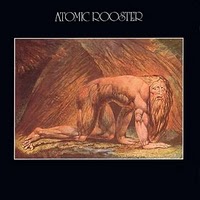 Death Walks Behind You opens with the title track – a study in what I would term doom rock (it’s in the direction of doom metal, but isn’t quite metal). It’s a good hard rocker with a nice riff; it starts off building a doom laden atmosphere real slow and then kicks into a blues rock theme; it’s perhaps a little too long. “V.U.G.” is an impressive instrumental piece, and “Tomorrow Night” (the single off the album) is an excellent simple rocker. It was my introduction to this great band. “Seven Lonely Streets” closes the 1st side. Despite an unconvincing vocal performance from Cann it has some good jamming and a brilliant hook – you know – the kind that’s still going through your head when you wake up in the middle of the night. On the second side “Sleeping For Years” is yet another good hard rocker with a great hook. “I Can’t Take No More” is kind of pop-rock, almost a precursor to the kind of song Cann would produce 10 years later. “Nobody Else” starts off nice and quiet on the piano before rocking out from about halfway. It’s pretty good, sort of contemplative. The last track, “Gerschatzer” (a german-sounding word with no meaning), is instrumental only. It starts off brightly but gets a bit messy, as much of what is termed ‘prog’ tends to. I would recommend this to anyone interested in hard rock, particularly of the Deep Purple or early Sabbath variety. This is possibly their best album, though it’s hard to pick out one of their first three albums. –Jim
Death Walks Behind You opens with the title track – a study in what I would term doom rock (it’s in the direction of doom metal, but isn’t quite metal). It’s a good hard rocker with a nice riff; it starts off building a doom laden atmosphere real slow and then kicks into a blues rock theme; it’s perhaps a little too long. “V.U.G.” is an impressive instrumental piece, and “Tomorrow Night” (the single off the album) is an excellent simple rocker. It was my introduction to this great band. “Seven Lonely Streets” closes the 1st side. Despite an unconvincing vocal performance from Cann it has some good jamming and a brilliant hook – you know – the kind that’s still going through your head when you wake up in the middle of the night. On the second side “Sleeping For Years” is yet another good hard rocker with a great hook. “I Can’t Take No More” is kind of pop-rock, almost a precursor to the kind of song Cann would produce 10 years later. “Nobody Else” starts off nice and quiet on the piano before rocking out from about halfway. It’s pretty good, sort of contemplative. The last track, “Gerschatzer” (a german-sounding word with no meaning), is instrumental only. It starts off brightly but gets a bit messy, as much of what is termed ‘prog’ tends to. I would recommend this to anyone interested in hard rock, particularly of the Deep Purple or early Sabbath variety. This is possibly their best album, though it’s hard to pick out one of their first three albums. –Jim
Jive Time Turntable
Rolling Stones “Hot Rocks” (1972)
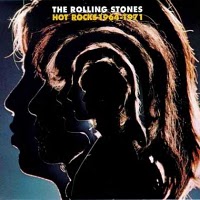 At this point in my life, every Rolling Stones record sounds like a greatest hits record. The younger, stupider me might go off on how the hits aren’t as good as the more obscure album cuts that nobody has heard, but let’s get real. Everybody has heard that stuff, just like everybody knows all the Beatles and Dylan songs on every album. Who are we trying to impress anymore? This is not private press psyche or hardcore. It’s the Stones, and when I want to listen to the Stones I want to hear Jumping Jack Flash go into Street Fighting Man go into Sympathy for the Devil, skip Honky Tonk Woman, then finish the side with Gimme Shelter (hot rocks record two, side one) At some point, you just got to pick up a worn copy of something that’s worth nothing just for the simple pleasure of rocking out. It’s a healthy reminder of why you listen to records in the first place. –Alex
At this point in my life, every Rolling Stones record sounds like a greatest hits record. The younger, stupider me might go off on how the hits aren’t as good as the more obscure album cuts that nobody has heard, but let’s get real. Everybody has heard that stuff, just like everybody knows all the Beatles and Dylan songs on every album. Who are we trying to impress anymore? This is not private press psyche or hardcore. It’s the Stones, and when I want to listen to the Stones I want to hear Jumping Jack Flash go into Street Fighting Man go into Sympathy for the Devil, skip Honky Tonk Woman, then finish the side with Gimme Shelter (hot rocks record two, side one) At some point, you just got to pick up a worn copy of something that’s worth nothing just for the simple pleasure of rocking out. It’s a healthy reminder of why you listen to records in the first place. –Alex
Sonic Youth “Daydream Nation” (1988)
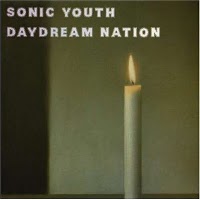 “Record collectors shouldn’t be in bands!” This is what Joe Carducci said when the other guys at SST records wanted to sign Sonic Youth in the mid eighties, And I can’t fully disagree with the statement. Sonic has spent their career as artsy NYC hipsters riding any and every genre of music that they may or may not have business making, as long as it’s “cool”. In the early days, it was mostly a band trying to balance with one foot in punk while holding on to their no wave and high art credibility. By the early nineties, they were consciously dumbing down to cash in on grunge riffs. But at some point between the two, they managed to create one of the best rock albums of all time, the massive double LP, Daydream Nation. It’s focused drive and sprawling experimentation come off so impressively natural. Somehow they balance a sort of psychedelic rock approach to slightly punk fueled pop songs with very DEAD C like noise drone outs that miraculously blend into a seamless late eighties indie record. Even the usually free flowing poetic vocals are at their least offensive. In fact most of the lyrics are amazing. It’s the band at their peak of maturity. The space inside each song seems to grow with each listen as well, which leads to what seems like endless repeated listenings. Sadly, the 4th side trails off into some annoying territory, but there’s so much to chew on already, and for the first three sides, nothing to skip. The sound suggests high art without the pretension overshadowing the human feel of the songs. Even Carducci later admitted that they were a good band in this period. That’s what I think impresses me the most about Sonic Youth; every instinct tells me that this band need’s to get real yet I always come back to them, and in Daydream’s case, rarely leave. –Alex
“Record collectors shouldn’t be in bands!” This is what Joe Carducci said when the other guys at SST records wanted to sign Sonic Youth in the mid eighties, And I can’t fully disagree with the statement. Sonic has spent their career as artsy NYC hipsters riding any and every genre of music that they may or may not have business making, as long as it’s “cool”. In the early days, it was mostly a band trying to balance with one foot in punk while holding on to their no wave and high art credibility. By the early nineties, they were consciously dumbing down to cash in on grunge riffs. But at some point between the two, they managed to create one of the best rock albums of all time, the massive double LP, Daydream Nation. It’s focused drive and sprawling experimentation come off so impressively natural. Somehow they balance a sort of psychedelic rock approach to slightly punk fueled pop songs with very DEAD C like noise drone outs that miraculously blend into a seamless late eighties indie record. Even the usually free flowing poetic vocals are at their least offensive. In fact most of the lyrics are amazing. It’s the band at their peak of maturity. The space inside each song seems to grow with each listen as well, which leads to what seems like endless repeated listenings. Sadly, the 4th side trails off into some annoying territory, but there’s so much to chew on already, and for the first three sides, nothing to skip. The sound suggests high art without the pretension overshadowing the human feel of the songs. Even Carducci later admitted that they were a good band in this period. That’s what I think impresses me the most about Sonic Youth; every instinct tells me that this band need’s to get real yet I always come back to them, and in Daydream’s case, rarely leave. –Alex
Morrissey “Viva Hate” (1988)
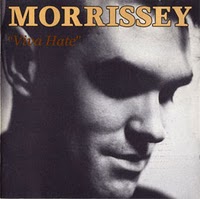 In the land ye fishey and chips, there would come about a band that would rocketh the stray teenagers of the middle class. They would defeat the masses of hair metal and 80s b-boys, but would ultimately be destroyed by time. There would be a man to rise out of the fire who would make an album better than half of said band’s. We would then call him Moz because that sounds cool and agree that he hasn’t been the same since (although You are the Quarry was a hell of a comback….ye olde You are the Quarry, I mean). Sexy British asshole male divas of the world unite. Only one, eh? –Allistair
In the land ye fishey and chips, there would come about a band that would rocketh the stray teenagers of the middle class. They would defeat the masses of hair metal and 80s b-boys, but would ultimately be destroyed by time. There would be a man to rise out of the fire who would make an album better than half of said band’s. We would then call him Moz because that sounds cool and agree that he hasn’t been the same since (although You are the Quarry was a hell of a comback….ye olde You are the Quarry, I mean). Sexy British asshole male divas of the world unite. Only one, eh? –Allistair
Uriah Heep “Demons and Wizards” (1972)
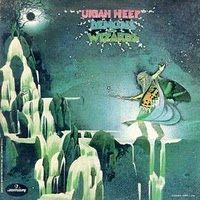 Uriah Heep’s 4th accentuates the pomp and bombast at the band’s core even further, “The Wizard” re-introducing us to the world of Demons and Wizards in grand, whisper to a scream style. Really, only two lively, pure of purpose rockers in this bunch, the good-timer “All My Life” and barreling “Easy Livin'” (the band’s first US top 40 entry). It’s imposing works of sorcery and heft like “Traveller in Time,” the hard swing of “Poet’s Justice,” which sounds in places like Scott Walker gone heavy (really!) and “Circle of Hands,” a majestic number recalling Zep’s “Thank You,” that one carries into the unquiet slumbers experienced after too many hours steeped in the Heep. Elsewhere, “Rainbow Demon” chains you to a Hyborian Wheel of Pain with it’s leaden, Iommi on organ riff, as Demons concludes with the meandering “Paradise/The Spell,” an alternately lush and rollicking soar towards the heavens. –Rob
Uriah Heep’s 4th accentuates the pomp and bombast at the band’s core even further, “The Wizard” re-introducing us to the world of Demons and Wizards in grand, whisper to a scream style. Really, only two lively, pure of purpose rockers in this bunch, the good-timer “All My Life” and barreling “Easy Livin'” (the band’s first US top 40 entry). It’s imposing works of sorcery and heft like “Traveller in Time,” the hard swing of “Poet’s Justice,” which sounds in places like Scott Walker gone heavy (really!) and “Circle of Hands,” a majestic number recalling Zep’s “Thank You,” that one carries into the unquiet slumbers experienced after too many hours steeped in the Heep. Elsewhere, “Rainbow Demon” chains you to a Hyborian Wheel of Pain with it’s leaden, Iommi on organ riff, as Demons concludes with the meandering “Paradise/The Spell,” an alternately lush and rollicking soar towards the heavens. –Rob
Curtis Mayfield “Curtis” (1970)
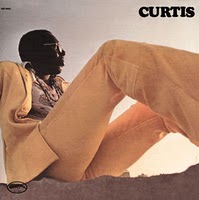 Curtis’s call to unity and peace is that we are all going to hell for being assholes; I absolutely love that. Here everyone is telling everyone to form a love train and hold hands and Curtis is saying that if things don’t work out now maybe we’ll get things right in hell. The music is just as revolutionary, an embrace of what was going down on the East side of the United States in the 60s and the music that has been going on in the western hemisphere since the 16th century. Dirty funk with prog-rock ascension (“(Don’t Worry) If There’s a Hell We’re All Going to Go”) and a Motown hit with a 5-minute jam (“Move On Up”), Curtis knows no limits and it’s all for the better; even simple soul like “Miss Black America” and “Wild and Free” feel like transcendent miracles of celebration with lyrical potency.
Curtis’s call to unity and peace is that we are all going to hell for being assholes; I absolutely love that. Here everyone is telling everyone to form a love train and hold hands and Curtis is saying that if things don’t work out now maybe we’ll get things right in hell. The music is just as revolutionary, an embrace of what was going down on the East side of the United States in the 60s and the music that has been going on in the western hemisphere since the 16th century. Dirty funk with prog-rock ascension (“(Don’t Worry) If There’s a Hell We’re All Going to Go”) and a Motown hit with a 5-minute jam (“Move On Up”), Curtis knows no limits and it’s all for the better; even simple soul like “Miss Black America” and “Wild and Free” feel like transcendent miracles of celebration with lyrical potency.
There’s The Last Poets who were looking at all the failures going on and then there was Isaac Hayes looking at a bright future, but both were either too cynical or scarred to look at each other. This is Curtis standing up aware of the shortcomings of black society in the late 60s (“Don’t accept anything less than 2nd best” he sings in triumphant glory) and looking up at the bright days behind the gloomiest haze of despair in the album’s centerpiece “We the People Who are Darker than Blue”. Curtis knows there is no point in pondering what could have been of Africa had it not been ravaged and he knows there is no use in lying about black people coming on top. There is no black and white, there is only poor or rich and lucky or unfortunate. You can only embrace those small moments when things are looking up in your life and you make a connection to the history that binds you to that moment. This is what Curtis accomplishes for forty minutes and it’s a beautiful thing. –Allistair
Alice Coltrane “Ptah The El Daoud” (1970)
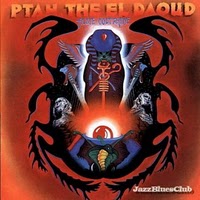 You can tell from the album cover that this isn’t going to be your average jazz album. In fact, it’s an essential avant-garde album to own. It’s proof that John Coltrane’s wife, Alice, was very talented. Ptah, The El Daoud is a unique opportunity to hear tenor saxophone legends Joe Henderson and Pharoah Sanders together. The first thing that strikes you when the record starts is that Ron Carter has so much power on bass. You can almost picture the damage that his playing is doing to your speakers. He’s incredible. My only complaint is that you can’t hear Alice Coltrane play piano and harp at the same time. She’s great on both instruments. If only she had two more arms! –Rob
You can tell from the album cover that this isn’t going to be your average jazz album. In fact, it’s an essential avant-garde album to own. It’s proof that John Coltrane’s wife, Alice, was very talented. Ptah, The El Daoud is a unique opportunity to hear tenor saxophone legends Joe Henderson and Pharoah Sanders together. The first thing that strikes you when the record starts is that Ron Carter has so much power on bass. You can almost picture the damage that his playing is doing to your speakers. He’s incredible. My only complaint is that you can’t hear Alice Coltrane play piano and harp at the same time. She’s great on both instruments. If only she had two more arms! –Rob
The Damned “Damned Damned Damned” (1977)
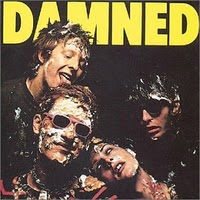 It might not be peanut butter, but no doubt that’s some Stooge flavored pie the Damned are licking up on the cover of Damned, Damned, Damned, an album that wallows in the same scuzzy punk sewer as the influential Detroit rockers, with tracks like “Born To Kill,” speed freakers “Neat Neat Neat,” “New Rose,” and the menacing Cooper-ish sneer of “Fan Club.” Given a brittle and brutal production job by Nick Lowe, the album rattles with a violent energy that rushes in and assaults your eardrums, running off with your wallet and girlfriend before you’ve had a chance to retaliate, as an appropriate cover of “I Feel Alright” slams the door shut. A simple, pure shot of snotty energy that’s refreshingly free of the political posturing of some other first-wave UK punk. –Ben
It might not be peanut butter, but no doubt that’s some Stooge flavored pie the Damned are licking up on the cover of Damned, Damned, Damned, an album that wallows in the same scuzzy punk sewer as the influential Detroit rockers, with tracks like “Born To Kill,” speed freakers “Neat Neat Neat,” “New Rose,” and the menacing Cooper-ish sneer of “Fan Club.” Given a brittle and brutal production job by Nick Lowe, the album rattles with a violent energy that rushes in and assaults your eardrums, running off with your wallet and girlfriend before you’ve had a chance to retaliate, as an appropriate cover of “I Feel Alright” slams the door shut. A simple, pure shot of snotty energy that’s refreshingly free of the political posturing of some other first-wave UK punk. –Ben
Frank Zappa “Freak Out!” (1966)
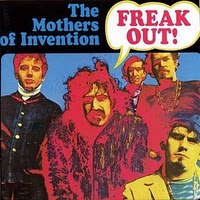 This is a true album for freaks. Back in 1967, Zappa must have felt left out of the hippy dippy counterculture because his musical interests seemed to extend beyond flowers in your hair, acoustic guitars and sitting barefoot in the park. So with this debut he in turn created a counterculture to the counterculture – an album for all the freaks and “left behinds” as he refers to them in the opening track Hungry Freaks Daddy. The music is frequently upbeat, jazzy and conventional, at least by Zappa’s standards. He had not yet started his long guitar explorations of later albums, and the only real “surreal” tracks are Who Are The Brain Police?, Help I’m A Rock, and the truly whacked out closer The Return Of The Son Of Monster Magnet. It’s these more experimental tracks that most intrigue me just in their sheer ludicrousness. They all sound like drug induced paranoia with their screaming, sound effects and seemingly made up language. –Neal
This is a true album for freaks. Back in 1967, Zappa must have felt left out of the hippy dippy counterculture because his musical interests seemed to extend beyond flowers in your hair, acoustic guitars and sitting barefoot in the park. So with this debut he in turn created a counterculture to the counterculture – an album for all the freaks and “left behinds” as he refers to them in the opening track Hungry Freaks Daddy. The music is frequently upbeat, jazzy and conventional, at least by Zappa’s standards. He had not yet started his long guitar explorations of later albums, and the only real “surreal” tracks are Who Are The Brain Police?, Help I’m A Rock, and the truly whacked out closer The Return Of The Son Of Monster Magnet. It’s these more experimental tracks that most intrigue me just in their sheer ludicrousness. They all sound like drug induced paranoia with their screaming, sound effects and seemingly made up language. –Neal
Caravan “In the Land of Grey and Pink” (1971)
Caravan turned in a classic with 1971’s “In the Land of Grey and Pink,” with their insistent grooves, tongue-in-cheek lyrics with a uniquely English bent, and Richard Sinclair’s expansive, jazzy organ solos, this album largely set the template for the Canterbury sound. Caravan’s penchant for a whimsical, nodding bounce combined with a strong melodic hook is featured on “Golf Girl,” “Love to Love You (And Tonight Pigs Will Fly),” and the driving title track and reaches a peak on “Winter Wine,” as the band turns in a darker hued, intricate track featuring fantasy imagery. “Winter Wine” foreshadows the album’s pièce de résistance, “Nine Feet Underground,” a meandering multi-part suite that features some killer instrumental excursions coupled with some of the album’s most ingratiating melodies. –Ben
Stevie Wonder “Innervisions” (1973)
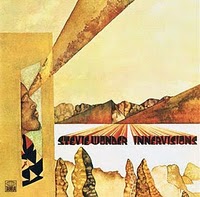 There is absolutely nothing like it. I could spend the entire review spouting off fawning superlatives, but suffice to say this is my favorite album of the 70’s, and my favorite non-jazz album of all time. From the opening chords, Stevie envelops you in a new type of funk; dark, complex and intense. “Too High”, “Higher Ground” and especially “Jesus Children of America” exemplify this sound, and they are what immediately grab you about the album. There is also gorgeous, emotional soul (“Golden Lady”, “All in Love is Fair”) and one track that lies in between (“Living for the City”). “Visions” is perhaps the most startling song, however. It isn’t really soul at all, and it’s definitely not funk. It’s a haunting and heart-felt meditation on the blindness of hatred that metiphorically contrasts it with Stevie’s own sightlessness. Just writing about this album gives me goosebumps, and if you’ve never heard it, you need to get on that, right now. –Lucas
There is absolutely nothing like it. I could spend the entire review spouting off fawning superlatives, but suffice to say this is my favorite album of the 70’s, and my favorite non-jazz album of all time. From the opening chords, Stevie envelops you in a new type of funk; dark, complex and intense. “Too High”, “Higher Ground” and especially “Jesus Children of America” exemplify this sound, and they are what immediately grab you about the album. There is also gorgeous, emotional soul (“Golden Lady”, “All in Love is Fair”) and one track that lies in between (“Living for the City”). “Visions” is perhaps the most startling song, however. It isn’t really soul at all, and it’s definitely not funk. It’s a haunting and heart-felt meditation on the blindness of hatred that metiphorically contrasts it with Stevie’s own sightlessness. Just writing about this album gives me goosebumps, and if you’ve never heard it, you need to get on that, right now. –Lucas
Prefab Sprout “Steve McQueen” (1985)
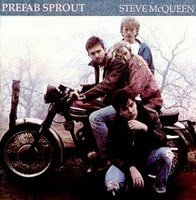 Saying Steve McQueen is easy listening, is like saying Twin Peaks was a soap opera. At first glance both statements seem true, yet both works have a way of distorting such unattractive mediums so much that it becomes something so different that could never be replicated again. Now Steven McQueen doesn’t have scary synths or a lady carrying logs narrating, so I’m going to kill that comparison now. Song by song, I have heard very few albums that measure up as well as Prefab Sprout’s crowning achievement. Listening over and over (sometimes five times in a row), I just start picking out individual moments in a song that add so much more charm and mystery to the bigger picture. Paddy McAloon has one of the best vocals in music, and just had the essence of someone you want to follow or know about simply through the power of his performance. Every song on here comes so close to the line between heartbreak and recovery, that they all capture the essence of both and never fail to move me. It’s something truly special and one of the greatest albums ever. Like at the end of The Great Escape when Steven McQueen is out running the germans on his motorcycle. He sadly flips out and ends up where he began, back in the camp. He didn’t succeed but he’s happy. Why? Because he’s Steve McQueen and that’s a bad mother fucker. –Allistair
Saying Steve McQueen is easy listening, is like saying Twin Peaks was a soap opera. At first glance both statements seem true, yet both works have a way of distorting such unattractive mediums so much that it becomes something so different that could never be replicated again. Now Steven McQueen doesn’t have scary synths or a lady carrying logs narrating, so I’m going to kill that comparison now. Song by song, I have heard very few albums that measure up as well as Prefab Sprout’s crowning achievement. Listening over and over (sometimes five times in a row), I just start picking out individual moments in a song that add so much more charm and mystery to the bigger picture. Paddy McAloon has one of the best vocals in music, and just had the essence of someone you want to follow or know about simply through the power of his performance. Every song on here comes so close to the line between heartbreak and recovery, that they all capture the essence of both and never fail to move me. It’s something truly special and one of the greatest albums ever. Like at the end of The Great Escape when Steven McQueen is out running the germans on his motorcycle. He sadly flips out and ends up where he began, back in the camp. He didn’t succeed but he’s happy. Why? Because he’s Steve McQueen and that’s a bad mother fucker. –Allistair


